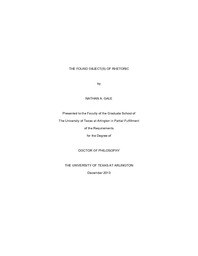
ATTENTION: The works hosted here are being migrated to a new repository that will consolidate resources, improve discoverability, and better show UTA's research impact on the global community. We will update authors as the migration progresses. Please see MavMatrix for more information.
Show simple item record
| dc.contributor.author | Gale, Nathan | en_US |
| dc.date.accessioned | 2014-03-12T23:48:34Z | |
| dc.date.available | 2014-03-12T23:48:34Z | |
| dc.date.issued | 2014-03-12 | |
| dc.date.submitted | January 2013 | en_US |
| dc.identifier.other | DISS-12444 | en_US |
| dc.identifier.uri | http://hdl.handle.net/10106/24070 | |
| dc.description.abstract | The following dissertation expands the notion of posthumanism beyond the work in transhumanism, new media studies, animal studies, and material feminism by incorporating speculative realist philosophies into and with the Aristotelian concept of "faculty" or dunamis. Since Aristotle defines rhetoric as a dunamis (or potential to persuade and/or be persuaded), but also uses the term in his Physics and Metaphysics to describe the contingent potentiality found in material objects, I argue for a posthuman rhetoric that recognizes extra-symbolic forms of persuasion. Drawing from the philosophical work of Levi Bryant, Graham Harman, and Ian Bogost coupled with the rhetorical work of Diane Davis, David Metzger, and Thomas Rickert, my dissertation argues that in order for current rhetorical thought to truly be posthuman, it must broaden the classical assumption that the material side of dunamis allows objects to not only move (as per Kenneth Burke's rhetoric), but to possibly act. | en_US |
| dc.description.sponsorship | Richardson, Timothy | en_US |
| dc.language.iso | en | en_US |
| dc.publisher | English | en_US |
| dc.title | The Found Object(s) Of Rhetoric | en_US |
| dc.type | Ph.D. | en_US |
| dc.contributor.committeeChair | Richardson, Timothy | en_US |
| dc.degree.department | English | en_US |
| dc.degree.discipline | English | en_US |
| dc.degree.grantor | University of Texas at Arlington | en_US |
| dc.degree.level | doctoral | en_US |
| dc.degree.name | Ph.D. | en_US |
Files in this item
- Name:
- Gale_uta_2502D_12444.pdf
- Size:
- 971.7Kb
- Format:
- PDF
This item appears in the following Collection(s)
Show simple item record


